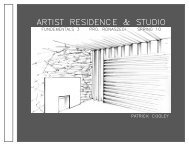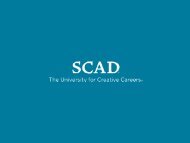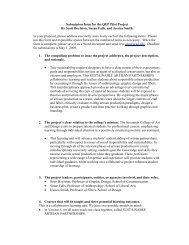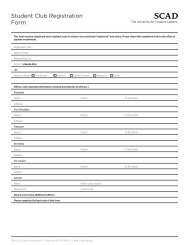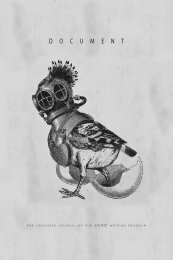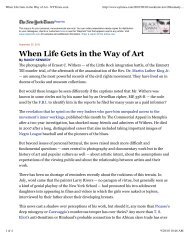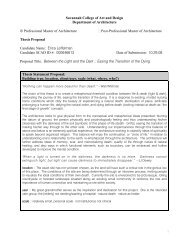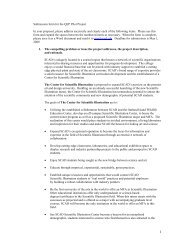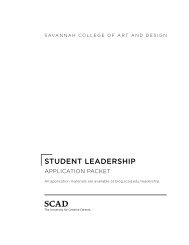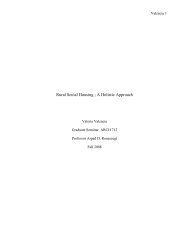Nicole Roberts MFA Thesis Visual Component Artwork - Savannah ...
Nicole Roberts MFA Thesis Visual Component Artwork - Savannah ...
Nicole Roberts MFA Thesis Visual Component Artwork - Savannah ...
Create successful ePaper yourself
Turn your PDF publications into a flip-book with our unique Google optimized e-Paper software.
EXPECTATION 3 | design discourse<br />
To become adept in expressing and defending<br />
the conceptual content of one’s work, it is largely<br />
understood that students must study art and design<br />
history, theory, and criticism. Today’s design students<br />
face a disturbing disconnection between the art and<br />
design discourse they study, and the design discourse<br />
they receive in their studio critiques. Design discourse<br />
is largely initiated by thinking out loud. Ideally, a<br />
student will verbally present visual concepts to the<br />
class by first restating the design problem, including<br />
researched aspects of audience, culture, competitor<br />
precedents, etc. Then a student will describe<br />
thoroughly how each design decision fundamentally<br />
serves to solve said problem, from the form to the<br />
color selection to the typeface and imagery choices.<br />
The student’s peers and professor are then cognizant<br />
of the designer’s intentions (visually successful or<br />
not) and may proceed to contribute to an informed<br />
critique. However, far too frequently this ideal<br />
scenario does not occur. Many times a classroom<br />
critique is merely quick judgment, while truly<br />
informed criticism must relate to in depth inquiry. 13<br />
I would revamp our Intro to<br />
Graphic Design course to include<br />
more history, understanding of<br />
current issues and designers as<br />
well as the various professional<br />
outcomes of the profession. It<br />
would be more seminar and<br />
discourse with less projects.<br />
Eric Benson, Professor<br />
University of Illinois<br />
Urbana, Illinois<br />
This is due in part to the increased complexity<br />
and new technology per student project, which often<br />
presents a learning curve for both professor and<br />
student, thus chipping away essential critique time.<br />
It can also be attributed to educators not enforcing<br />
formal studio presentations, which in turn allows<br />
undergraduates to connote a lax approach to design<br />
discourse. Despite these challenges, educators are well<br />
aware of the significance of design discourse within<br />
today’s design education. Introductory courses are where<br />
the precedent for discourse must begin. Thereafter, each<br />
design project must originate with formal written and<br />
verbal presentations. By educators necessitating written<br />
creative briefs and proposals at the start and artist’s<br />
statements at the conclusion of studio coursework,<br />
students will develop more authority over their visual<br />
communication through an author’s perspective.<br />
The study of design discourse has presented<br />
designers of the twenty-first century with the insight<br />
and capability to no longer restrict them to simply<br />
mediating the text. Graphic designers have expanded to<br />
not only be creators of form, but also of the audience<br />
and of the textual message itself. Principal of 2x4,<br />
Inc. – Michael Rock calls for “an examination of the<br />
designer-as-author” relationship. “[It] could help us to<br />
rethink process, expand design methods, and elaborate<br />
our historical frame to incorporate all forms of graphic<br />
discourse.” 14 As a catalyst for the future of graphic<br />
design and the number one ranked shortcoming of new<br />
graduates, educators must push design discourse to the<br />
forefront of pedagogical priorities, while maintaining<br />
the balance between critical thought and technical<br />
proficiency. By accompanying every design project with<br />
formal written and verbal presentations, students will<br />
be more prepared for this expectation upon entering<br />
the professional workplace.<br />
21



